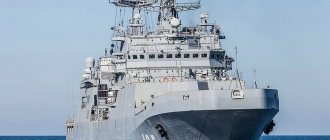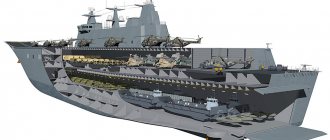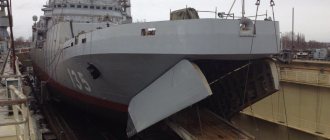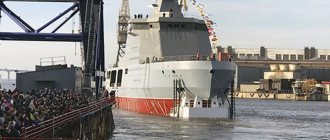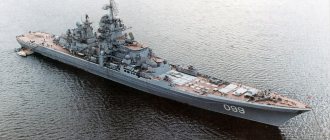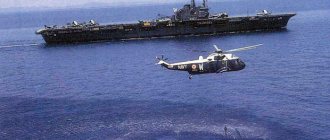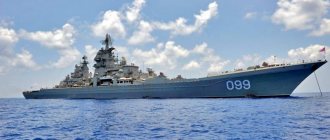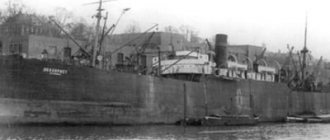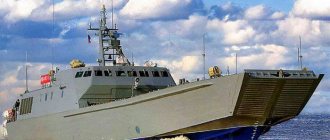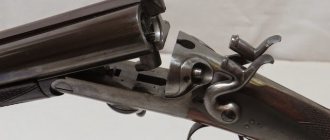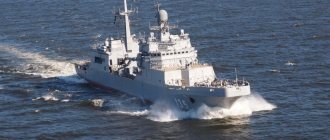Large landing ship of the "Ivan Rogov" type, pr. 1174
The tactical and technical specifications for the construction of large landing ships of Project 1174 were issued by the Navy to the Nevsky Design Bureau (PKB) in September 1964. P.P. was appointed chief designer of the project. Milovanov, and the main observer from the Navy was Captain 2nd Rank A.V. Bekhterev.
The development of this complex and new ship for domestic practice was accompanied by comprehensive design and military-economic studies, in which the Central Research Institute took part together with the Nevsky Design Bureau. acad. A.N. Krylov and the First Central Research Institute of the RF Ministry of Defense (Navy shipbuilding), as well as other organizations. The preliminary design of the large landing craft was approved in October 1965, and the corrected technical design in May 1968.
As a result, a landing ship of an original design, which had no analogues in world practice, was developed, capable of landing military units both directly on the shore and without approaching it: floating equipment - on the water, non-floating equipment - with the help of landing craft, and personnel landing with portable weapons - by helicopter.
The large landing ship of the ocean zone 1174 "Ivan Rogov" is designed for transportation and landing on both equipped and unequipped coasts with a low bottom slope of landing forces with military equipment. The ship can transport and land troops up to a motorized rifle battalion, including 440 people and 79 pieces of equipment (armored personnel carriers, infantry fighting vehicles, tanks, cars, etc.) or a tank unit with 46 main battle tanks.
The Ivan Rogov class BDK is a multi-deck ship with a forecastle and a developed aft superstructure. In its bow there is a tank hold (length 54 m, width 12 m, height about 5 m), and in the stern there is a dock chamber (length 75 m, width 12 m, height about 10 m). The slipway deck is located one tweendeck below the tank deck.
For loading equipment from the pier when mooring stern, as well as for receiving watercraft into the docking chamber and unloading them from it, the transom has a lap port with a folding hermetic closure, which in the lowered position serves as a gangway for the passage of equipment.
The movement of equipment around the ship is carried out by three gangways with hydraulic drives: one is located between the docking chamber and the tank hold (in the raised position it serves as a bulkhead separating these rooms) and the other two are between the upper and tank decks.
The tank hold, dock chamber (if there are no watercraft in it) and the upper deck can accommodate either about 50 tanks, or up to 80 armored personnel carriers and infantry fighting vehicles, or up to 120 vehicles or mobile equipment in any other combinations. The landing personnel are housed in several cockpits and 4-berth officer cabins.
The bow landing device includes a bow gate and a retractable gangway about 32 m long, which in the stowed position is located under the upper deck and is extended using a hydraulic drive. Landing of troops with non-floating equipment can be carried out directly on an unequipped coast with a minimum bottom slope of 2 - 3 degrees (depending on the total mass of cargo taken on board the ship) with a fording depth at the end of the gangplank of no more than 1.2 m.
To unload non-floating equipment without approaching the shore, six landing boats of Project 1785 (speed 7.5 knots), or Project 1176 “Akula” (speed of over 10 knots), or three landing boats on air can be taken into the docking chamber cushion of project 1206 “Squid” (speed up to 50 knots). The docking chamber can also accommodate new high-speed (up to 32 kts) air-cavity landing craft of Project 11770 “Serna”. Each of the listed landing craft is capable of transporting one tank or other mobile equipment, depending on capacity.
The ship can host four Ka-29 transport and combat helicopters, capable of receiving 16 paratroopers. The helicopter is capable of providing fire support to the landing force. The helicopter hangar is located in the superstructure between two landing pads.
The ship's armament includes the Osa-M anti-aircraft self-defense missile system (one twin launcher, 20 missiles), a two-gun 76.2-mm AK-726 artillery mount with an MP-105 radar fire control system and four 30-mm AK-type assault rifles -630 with two MP-123 type radar fire control systems (two on each side). In addition, to engage coastal targets, the BDK is equipped with a launcher for one Grad-M multiple launch rocket system (range of about 20 km).
The ship is equipped with a three-dimensional general detection radar of the MR-310A type, two navigation radars and advanced radio communications. Passive electronic warfare systems and means of detecting and destroying underwater saboteurs are also provided.
The main power plant (GEM) includes two gas turbine units with a power of up to 18,000 hp, powered by two propellers. The power plant is located in echelon in two side compartments, and auxiliary mechanisms are located between them under the slipway deck. The sources of electricity are six diesel generators with a power of up to 500 kW.
Tested in the Experimental Pool of the Central Research Institute named after. acad. A.N. The Krylov shape of the ship's hull contours with a structural trim to the stern, a bow bulb and waterlines pointed at the bow ensured the achievement of a high full speed for a landing ship with a bow landing device (21 knots) with good landing characteristics and practically unlimited seaworthiness.
The ship's autonomy (in terms of provisions) reaches 15-30 days (when transporting 500 and 250 paratroopers, respectively). The crew numbers about 250 people. The ship is equipped with a system for receiving liquid and solid cargo at sea.
Project 1174 ships were built in Kaliningrad at the Baltic Shipbuilding Plant. The lead ship "Ivan Rogov" was laid down in September 1973 and delivered to the Navy in June 1978. The second ship, Alexander Nikolaev, was commissioned in 1982, and the third, Mitrofan Moskalenko, was commissioned in 1989. The latest BDK installed a number of new types of combat and technical equipment.
Being universal landing ships, well suited for long-term operations in remote areas, Project 1174 ships are suitable for participation in operations of any scale at any distance from their bases.
Development history
The tactical and technical specifications for the design of a large landing ship of Project 1174, code "Rhinoceros", were issued in September 1964. As in the BDK of Project 1171, the new project, at the request of the Commander-in-Chief of the USSR Navy, Admiral S.G. Gorshkov, included a requirement for direct landing of troops at the water's edge.
The development was carried out by the Nevsky Design Bureau. P.P. Milovanov was appointed chief designer, and captain 2nd rank A.V. Bekhterev was appointed chief naval observer. During the design process, information appeared about the construction program in the United States for the Tarawa-type UDC. Therefore, at the direction of the Commander-in-Chief, changes were made to the project. A docking chamber appeared and the composition of the air group was increased. These changes led to the creation of an original universal landing ship with a relatively small displacement[1]. The Central Research Institute named after Academician A. N. Krylov, the First Central Research Institute of the USSR Ministry of Defense and other organizations took part in the development of the ship. In October 1965, the preliminary design was approved. And in May 1968, the technical project was approved[2].
Due to constant changes in the design, the lead BDK of Project 1174 “Ivan Rogov” was built at the Yantar Shipyard in Kaliningrad only in 1978, 14 years after the issuance of the TTZ[1].
In the final version, the new BDK could land troops using the bow landing device on an unequipped coast and water, and using the stern landing device from the dock chamber onto the water or using landing boats. With the help of the bow gangway, the BDK was capable of landing on 17% of the coast, and with the help of boats - up to 40%. With the help of four Ka-29 helicopters (each can carry up to 16 paratroopers), the landing could be carried out anywhere[1].
Notes
- ↑ 12345
Kuzin and Nikolsky, p.248 - ↑ 1234
[warships.ru/Russia/Fighting_Ships/Amphibious_Ships/ Project 1174 landing ships] - [www.navalcadet.narod.ru/1174.htm MITROFAN MOSKALENKO]
- [wp.scn.ru/ru/carriers/wars/1/189-1-0#189-1-0 WINGS PALETTE – Aircraft Carriers]
- [wp.scn.ru/ru/carriers/wars/1/190-1-0#190-1-0 WINGS PALETTE — Aircraft Carriers]
- ↑ 12
[www.gazeta.ru/politics/2014/12/22_a_6355693.shtml “Rhinos” to replace “Mistrals”] - ↑ 12
[vpk-news.ru/news/25408 “Rhinos” can temporarily replace “Mistrals”] - [wp.scn.ru/ru/carriers/wars/1/188-1-0#188-1-0 WINGS PALETTE — Aircraft Carriers]
- [flot.com/news/navy/index.php?ELEMENT_ID=165461 The Ministry of Defense is selling ships and vessels for scrap. 5.5.2014]
Composition of the series
| Name | Head No. | Pawned | Launching | Commissioning | Current status |
| "Ivan Rogov" | 101 | 09.1973 | 31.05.1977 | 15.06.1978 | Decommissioned in 1996[4], dismantled for metal in the dry dock "DalLarge landing ships of project 1174" |
An excerpt characterizing the Project 1174 Large Landing Ships
Between the guns, at a height, the chief of the rearguard, a general, and a retinue officer stood in front, examining the terrain through a telescope. Somewhat behind, Nesvitsky, sent from the commander-in-chief to the rearguard, sat on the trunk of a gun. The Cossack accompanying Nesvitsky handed over a handbag and a flask, and Nesvitsky treated the officers to pies and real doppelkümel. The officers joyfully surrounded him, some on their knees, some sitting cross-legged on the wet grass. - Yes, this Austrian prince was not a fool to build a castle here. Nice place. Why don't you eat, gentlemen? - Nesvitsky said. “I humbly thank you, prince,” answered one of the officers, enjoying talking with such an important staff official. - Beautiful place. We walked past the park itself, saw two deer, and what a wonderful house! “Look, prince,” said the other, who really wanted to take another pie, but was ashamed, and who therefore pretended that he was looking around the area, “look, our infantry have already climbed there.” Over there, in the meadow outside the village, three people are dragging something. “They will break through this palace,” he said with visible approval. “Both,” said Nesvitsky. “No, but what I would like,” he added, chewing the pie in his beautiful, moist mouth, “is to climb up there.” He pointed to a monastery with towers visible on the mountain. He smiled, his eyes narrowed and lit up. - But that would be good, gentlemen! The officers laughed. - At least scare these nuns. Italians, they say, are young. Really, I would give five years of my life! “They’re bored,” said the bolder officer, laughing. Meanwhile, the retinue officer standing in front was pointing something out to the general; the general looked through the telescope. “Well, so it is, so it is,” the general said angrily, lowering the receiver from his eyes and shrugging his shoulders, “and so it is, they will attack the crossing.” And why are they hanging around there? On the other side, the enemy and his battery were visible to the naked eye, from which milky white smoke appeared. Following the smoke, a distant shot was heard, and it was clear how our troops hurried to the crossing. Nesvitsky, puffing, stood up and, smiling, approached the general. - Would your Excellency like to have a snack? - he said. “It’s not good,” said the general, without answering him, “our people hesitated.” – Shouldn’t we go, Your Excellency? – said Nesvitsky. “Yes, please go,” said the general, repeating what had already been ordered in detail, “and tell the hussars to be the last to cross and light the bridge, as I ordered, and also to inspect the flammable materials on the bridge.” “Very good,” answered Nesvitsky. He called to the Cossack with the horse, ordered him to remove his purse and flask, and easily threw his heavy body onto the saddle. “Really, I’ll go see the nuns,” he said to the officers, who looked at him with a smile, and drove along the winding path down the mountain. - Come on, where will it go, captain, stop it! - said the general, turning to the artilleryman. - Have fun with boredom. - Servant to the guns! - the officer commanded. And a minute later the artillerymen ran out cheerfully from the fires and loaded. - First! - a command was heard. Number 1 bounced smartly. The gun rang metallic, deafening, and a grenade flew whistling over the heads of all our people under the mountain and, not reaching the enemy, showed with smoke the place of its fall and burst. The faces of the soldiers and officers brightened at this sound; everyone got up and began observing the clearly visible movements of our troops below and in front of the movements of the approaching enemy. At that very moment the sun completely came out from behind the clouds, and this beautiful sound of a single shot and the shine of the bright sun merged into one cheerful and cheerful impression. Two enemy cannonballs had already flown over the bridge, and there was a crush on the bridge. In the middle of the bridge, having dismounted from his horse, pressed with his thick body against the railing, stood Prince Nesvitsky. He, laughing, looked back at his Cossack, who, with two horses in the lead, stood a few steps behind him. As soon as Prince Nesvitsky wanted to move forward, the soldiers and carts again pressed on him and again pressed him against the railing, and he had no choice but to smile. - What are you, my brother! - the Cossack said to the Furshtat soldier with the cart, who was pressing on the infantry crowded with the very wheels and horses, - what are you! No, to wait: you see, the general has to pass. But furshtat, not paying attention to the name of the general, shouted at the soldiers blocking his way: “Hey!” fellow countrymen! keep left, wait! “But the fellow countrymen, crowding shoulder to shoulder, clinging with bayonets and without interruption, moved along the bridge in one continuous mass. Looking down over the railing, Prince Nesvitsky saw the fast, noisy, low waves of Ens, which, merging, rippling and bending around the bridge piles, overtook one another. Looking at the bridge, he saw equally monotonous living waves of soldiers, coats, shakos with covers, backpacks, bayonets, long guns and, from under the shakos, faces with wide cheekbones, sunken cheeks and carefree tired expressions, and moving legs along the sticky mud dragged onto the boards of the bridge . Sometimes, between the monotonous waves of soldiers, like a splash of white foam in the waves of Ens, an officer in a raincoat, with his own physiognomy different from the soldiers, squeezed between the soldiers; sometimes, like a sliver of wood winding along the river, a foot hussar, an orderly or a resident was carried across the bridge by waves of infantry; sometimes, like a log floating along the river, surrounded on all sides, a company or officer's cart, piled to the top and covered with leather, floated across the bridge. “Look, they’ve burst like a dam,” the Cossack said, stopping hopelessly. -Are there many of you still there? – Melion without one! - a cheerful soldier walking nearby in a torn overcoat said winking and disappeared; another, old soldier walked behind him. “When he (he is the enemy) begins to fry the taperich on the bridge,” the old soldier said gloomily, turning to his comrade, “you will forget to itch.” And the soldier passed by. Behind him another soldier rode on a cart. “Where the hell did you stuff the tucks?” - said the orderly, running after the cart and rummaging in the back. And this one came with a cart. This was followed by cheerful and apparently drunk soldiers. “How can he, dear man, blaze with the butt right in the teeth…” one soldier in an overcoat tucked high said joyfully, waving his hand widely. - This is it, sweet ham is that. - answered the other with laughter. And they passed, so Nesvitsky did not know who was hit in the teeth and what the ham was. “They’re in such a hurry that he let out a cold one, so you think they’ll kill everyone.” - the non-commissioned officer said angrily and reproachfully. “As soon as it flies past me, uncle, that cannonball,” said the young soldier, barely restraining laughter, with a huge mouth, “I froze.” Really, by God, I was so scared, it’s a disaster! - said this soldier, as if boasting that he was scared. And this one passed. Following him was a carriage, unlike any that had passed so far. It was a German steam-powered forshpan, loaded, it seemed, with a whole house; tied behind the forshpan that the German was carrying was a beautiful, motley cow with a huge udder. On the feather beds sat a woman with a baby, an old woman and a young, purple-red, healthy German girl. Apparently, these evicted residents were allowed through with special permission. The eyes of all the soldiers turned to the women, and while the cart passed, moving step by step, all the soldiers' comments related only to two women. Almost the same smile of lewd thoughts about this woman was on all their faces. - Look, the sausage is also removed! “Sell mother,” another soldier said, stressing the last syllable, turning to the German, who, with his eyes downcast, walked angrily and fearfully with wide steps. - How did you clean up! Damn it! “If only you could stand with them, Fedotov.” - You saw it, brother! - Where are you going? - asked the infantry officer who was eating an apple, also half-smiling and looking at the beautiful girl. The German, closing his eyes, showed that he did not understand. “If you want, take it for yourself,” the officer said, handing the girl an apple. The girl smiled and took it. Nesvitsky, like everyone else on the bridge, did not take his eyes off the women until they passed. When they passed, the same soldiers walked again, with the same conversations, and finally everyone stopped. As often happens, at the exit of the bridge the horses in the company cart hesitated, and the entire crowd had to wait. - And what do they become? There is no order! - said the soldiers. -Where are you going? Damn! There's no need to wait. Even worse, he will set the bridge on fire. “Look, they’ve locked up the officer too,” the stopped crowds said from different sides, looking at each other, and still huddled forward towards the exit. Looking under the bridge at the waters of Ens, Nesvitsky suddenly heard a sound that was still new to him, quickly approaching... something big and something plopping into the water. - Look where it's going! – the soldier standing close said sternly, looking back at the sound. “He’s encouraging them to pass quickly,” said another restlessly. The crowd moved again. Nesvitsky realized that it was the core. - Hey, Cossack, give me the horse! - he said. - Well you! stay away! step aside! way! With great effort he reached the horse. Still screaming, he moved forward. The soldiers squeezed to give him way, but again they pressed on him again so that they crushed his leg, and those closest were not to blame, because they were pressed even harder. - Nesvitsky! Nesvitsky! You, madam! – a hoarse voice was heard from behind. Nesvitsky looked around and saw, fifteen paces away, separated from him by a living mass of moving infantry, red, black, shaggy, with a cap on the back of his head and a brave mantle draped over his shoulder, Vaska Denisov. “Tell them, the devils, to give the dog,” he shouted. Denisov, apparently in a fit of ardor, shining and moving his coal-black eyes with inflamed whites and waving his unsheathed saber, which he held with a bare little hand as red as his face. - Eh! Vasya! – Nesvitsky answered joyfully. - What are you talking about? “Eskadg’on can’t leave,” shouted Vaska Denisov, angrily opening his white teeth, spurring his beautiful black, bloody Bedouin, who, blinking his ears from the bayonets he bumped into, snorting, spraying foam from the mouthpiece around him, ringing, he beat his hooves on the boards of the bridge and seemed ready to jump over the railings of the bridge if the rider would allow him. - What is this? like bugs! exactly the same as the bugs! Pg'och... give the dog!... Stay there! you're a cart, why not! I'll kill you with a saber! - he shouted, actually taking out his saber and starting to wave it.
